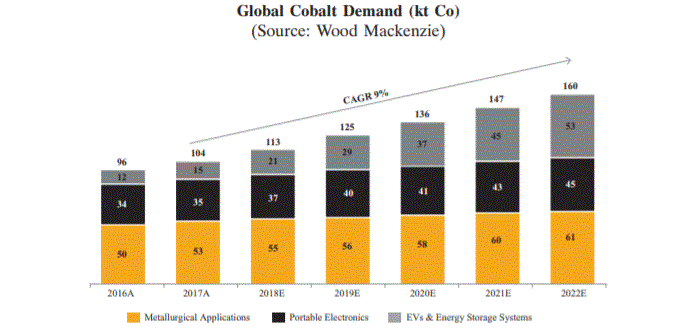The following content is excerpted from the prospectus of Battery Mineral Resources Limited dated June 19, 2018 filed on SEDAR.
Cobalt ("Co") is a hard, lustrous, grayish-silver metallic element with low thermal and electrical
conductivity. The unique properties of cobalt and cobalt products are responsible for its extensive applications in
energy storage, industrial and other areas. These characteristics include its (i) high-energy density, (ii) ability to
alloy and impart strength at high temperatures, and (iii) ferromagnetic properties.
Cobalt is usually brought to market as a raw material in the form of cobalt metal for chemical or
metallurgical purposes. Chemical applications of cobalt are dominated by the rechargeable batteries segment.
Darton Commodities Limited estimates that approximately 50% of the world's cobalt supply is used in the
rechargeable battery industry where cobalt is an important component in lithium-ion batteries with additional
uses in nickel metal hydride batteries and nickel cadmium batteries. Lithium-ion batteries can be divided into
five main chemistries with three containing cobalt.
- Lithium cobalt oxide ("LCO") - LiCoO2
- Lithium nickel manganese cobalt oxide ("NMC") - LiNiMnCoO2
- Lithium nickel cobalt aluminum oxide ("NCA") - LiNiCoAlO2

Metallurgical cobalt is the second largest cobalt consuming market and is used to produce superalloys.
Superalloys consist of cobalt with other metals such as nickel and/or iron and are heat resistant, surface stable,
and corrosion and oxidation resistant materials for industrial applications. Cobalt superalloys are widely used in
aerospace, electricity generation, aircraft, medical, automotive, and military related industries. Other
applications for metallurgical cobalt include hard metals and diamond tools, catalysts in oil and gas refinement,
as well as pigments and other industrial uses.
Cobalt Demand
Wood Mackenzie estimates global cobalt demand was approximately 104 kt in 2017, up 9% from the 96 kt
of cobalt consumed in 2016. By 2022 Wood Mackenzie expects global cobalt demand to reach 160 kt, and a
CAGR of 9% is predicted over the next five years. Approximately 49% of 2017 cobalt production was used in
battery manufacturing and the lithium-ion battery industry is expected to increase its share to approximately
62% of cobalt consumption by 2022. The increase in cobalt demand over the next five years will primarily be
driven by battery markets as consumers shift towards EVs over traditional combustion engine vehicles.
Wood Mackenzie estimates approximately 49% of the global cobalt demand in 2018 will come from
metallurgical applications and 51% from chemical applications. By 2022, 38% of the global cobalt demand is
expected to come from metallurgical applications and 62% from chemical applications.

Cobalt Supply
Cobalt is typically found with copper and nickel ores and is predominantly mined as a by-product of these
metals. The majority of mine production in these mines can be attributed to copper and nickel. Primary cobalt
mines account for less than 2% of global cobalt production.
Cobalt reserves are predominantly found in the African Copper Belt, primarily in the southern region of the
Democratic Republic of Congo ("DRC"). Global cobalt reserves are estimated by the United States Geological
Survey ("USGS") to be at 7 million tonnes with approximately 50% of these reserves located in the DRC.
According to the Fraser Institute's 2018 Policy Perception Index which assesses attractiveness of mining policies
in a jurisdiction, the DRC ranks in the bottom 25th percentile. In comparison, Ontario and Quebec rank in the
top 25
th percentile, illustrating the attractiveness of Canada as a mining jurisdiction.
Wood Mackenzie estimates global cobalt supply to be approximately 121 kt in 2018 with nearly 70% of
production expected to be from the DRC. Over the next five years, Wood Mackenzie anticipates cobalt supply to
grow at a 10% CAGR reaching 175 kt by 2022 with the DRC's contribution increasing by 10% to approximately
80% of global mine production.
Cobalt Market Imbalance and Pricing
Based on Wood Mackenzie analysis, supply has marginally outstripped demand over the last two years with
expectations of an average supply surplus of 18 kt over 2018 and 2019. Despite the supply surplus, cobalt prices
responded favorably over the last two years.
In mid-May 2018, refined cobalt prices on the London Metal Market traded above US$90,250/t
(US$40.90/lb), reflecting a 66% increase in one year from a price of US$54,500/t (US$24.70/lb). Concerns
regarding ethical mining practices, increasing political uncertainty in the DRC and policy changes including tax
increases and governmental interventions in the DRC as well as the expected increase of cobalt demand were
important factors for the recent strengthening of cobalt prices.